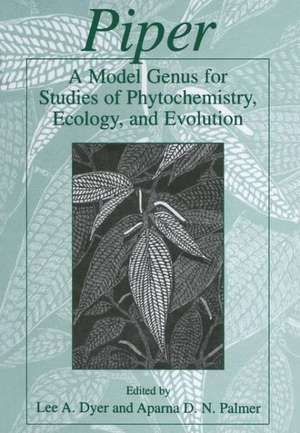Piper: A Model Genus for Studies of Phytochemistry, Ecology, and Evolution
Editat de Lee A. Dyer, Aparna Palmeren Limba Engleză Paperback – 12 dec 2012
The diversity and ecological relevance of this genus makes it an obvious candidate for ecological and evolutionary studies, but surprisingly, most research on Piper spp. to-date has focused on the more economically important plants P. nigrum (black pepper), P. methysticum (kava), and P. betle (betel leaf). While this book does address the applied techniques of studying Piper, its focus is more on Piper in its natural setting. Piper: A Model Genus for Studies of Phytochemistry, Ecology, and Evolution synthesizes existing data and provides an outline for future investigations of the chemistry, ecology, and evolution of this taxon, while examining its key themes of Piper as a model genus for ecological and evolutionary studies, the important ecological roles of Piper species in lowland wet forests, and the evolution of distinctive Piper attributes.
This volume has a place in the libraries of those studying or working in the fields of ecology, evolutionary biology, natural products chemistry, invasive species biology, pharmaceutics, and ethnobotany.
| Toate formatele și edițiile | Preț | Express |
|---|---|---|
| Paperback (1) | 1092.58 lei 6-8 săpt. | |
| Springer Us – 12 dec 2012 | 1092.58 lei 6-8 săpt. | |
| Hardback (1) | 1103.03 lei 6-8 săpt. | |
| Springer Us – 30 aug 2004 | 1103.03 lei 6-8 săpt. |
Preț: 1092.58 lei
Preț vechi: 1150.09 lei
-5% Nou
Puncte Express: 1639
Preț estimativ în valută:
209.08€ • 216.97$ • 174.76£
209.08€ • 216.97$ • 174.76£
Carte tipărită la comandă
Livrare economică 15-29 martie
Preluare comenzi: 021 569.72.76
Specificații
ISBN-13: 9781475710083
ISBN-10: 1475710089
Pagini: 232
Ilustrații: XVI, 214 p.
Greutate: 0.38 kg
Ediția:Softcover reprint of the original 1st ed. 2004
Editura: Springer Us
Colecția Springer
Locul publicării:New York, NY, United States
ISBN-10: 1475710089
Pagini: 232
Ilustrații: XVI, 214 p.
Greutate: 0.38 kg
Ediția:Softcover reprint of the original 1st ed. 2004
Editura: Springer Us
Colecția Springer
Locul publicării:New York, NY, United States
Public țintă
ResearchCuprins
1. Introduction.- 2. Mutualism, Antiherbivore Defense, and Trophic Cascades: Piper Ant-Plants as a Mesocosm for Experimentation.- 2.1. Introduction.- 2.2. Study Sites.- 2.3. Plants.- 2.4. Herbivores.- 2.5. Ant Mutualists.- 2.6. Top Predators.- 2.7. Other Endophytic Arthropods, Nematodes, and Annelids.- 2.8. Mutualism Experiments.- 2.9. Tritrophic Interactions and Antiherbivore Defense.- 2.10. Trophic Cascades.- 2.11. Conclusions.- 2.12. Acknowledgments.- 3. Pollination Ecology and Resource Partitioning in Neotropical Pipers.- 3.1. Introduction.- 3.2. Pollination and Resource Partitioning in Piper.- 3.3. Conclusions: Pollination and Resource Partitioning of Pipers in Light of Evolutionary and Conservative Ecology.- 3.4. Guidelines for Future Research on the Pollination of Pipers.- 3.5. Acknowledgments.- 4. Dispersal Ecology of Neotropical Piper Shrubs and Treelets.- 4.1. Introduction.- 4.2. The Piper Bats.- 4.3. Piper Fruiting Phenology and Dispersal Ecology.- 4.4. Coevolutionary Aspects of Bat-Piper Interactions.- 4.5. Conclusions.- 4.6. Acknowledgments.- 5. Biogeography of Neotropical Piper.- 5.1. Introduction.- 5.2. Methods.- 5.3. Results.- 5.4. Discussion.- 5.5. Acknowledgments.- 6. Faunal Studies in Model Piper spp. Systems, with a Focus on Spider-Induced Indirect Interactions and Novel Insect-Piper Mutualisms.- 6.1. Introduction.- 6.2. The Case of Piper obliquum.- 6.3. The Case of Piper urostachyum.- 6.4. Summary and Conclusions.- 6.5. Acknowledgments.- 7. Isolation, Synthesis, and Evolutionary Ecology of Piper Amides.- 7.1. Introduction to Piper Chemistry.- 7.2. Isolation and Quantification of Piper Amides.- 7.3. Synthesis of Piper Amides and Their Analogs.- 7.4. Ecology of Piper Chemistry.- 7.5. Evolution of Piper Chemistry.- 7.6. Applied Piper Chemistry.- 7.7. Future Research on Piper Chemistry.- 7.8. Acknowledgments.- 8. Kava (Piper methysticum): Growth in Tissue Culture and In Vitro Production of Kavapyrones.- 8.1. Introduction.- 8.2. Origins of Kava Use and Discovery by Western Cultures.- 8.3. Description of Kava (Piper methysticum) and Its Growth for Use in Kava Production.- 8.4. Active Phytochemicals Present in Kava Extracts.- 8.5. Issues Regarding the Potential Hepatotoxicity of Kava Extracts.- 8.6. Significance of Tissue Culture Growth in Kava Production and Phytochemical Research.- 8.7. Establishment of Kava Cell Cultures and the Determination of In Vitro Kavapyrone Production.- 8.8. Regeneration of Viable Kava Plants from Kava Cell Cultures.- 8.9. Summary and Perspective.- 9. Phylogenetic Patterns, Evolutionary Trends, and the Origin of Ant—Plant Associations in Piper Section Macrostachys: Burger’s Hypotheses Revisited.- 9.1. Introduction.- 9.2. Taxonomic History of Piper sect. Macrostachys (MIQ.) C.DC..- 9.3. Natural History of Piper sect. Macrostachys.- 9.4. Phylogenetic Relationships in Piper sect. Macrostachys.- 9.5. Burger’s Hypotheses Revisited.- 9.6. Ant-Plant Associations in Piper sect. Macrostachys.- 9.7. Conclusions.- Appendix 9.1.- 10. Current Perspectives on the Classification and Phylogenetics of the Genus Piper L..- 10.1. Introduction.- 10.2. Classification.- 10.3. Phylogeny.- 10.4. Evolutionary Aspects.- 10.5. Acknowledgments.- Appendix 10.1.- 11. Future Research in Piper Biology.- 11.1. Introduction.- 11.2. Plant-Animal Interactions.- 11.3. Abiotic Factors.- 11.4. Geographical Distribution.- 11.5. Summary.
Recenzii
From the reviews:
"This slim volume approaches comparative biology from a perspective rarely seen in book-length treatments. … The book’s premise is that species-rich lineages such as Piper are convenient models for studying questions of general interest using comparative methods. … The book is generally well edited … . The book is also attractively produced. … How well does the book do in attaining its objectives? Fairly well, given the gaps that exist in our knowledge of the genus." (Doyle McKey, Ecology, Vol. 86 (7), 2005)
"This slim volume approaches comparative biology from a perspective rarely seen in book-length treatments. … The book’s premise is that species-rich lineages such as Piper are convenient models for studying questions of general interest using comparative methods. … The book is generally well edited … . The book is also attractively produced. … How well does the book do in attaining its objectives? Fairly well, given the gaps that exist in our knowledge of the genus." (Doyle McKey, Ecology, Vol. 86 (7), 2005)













